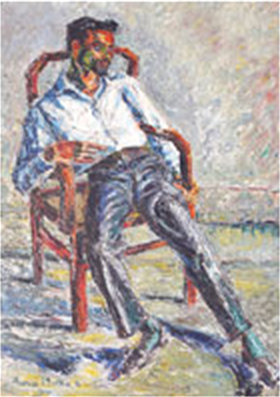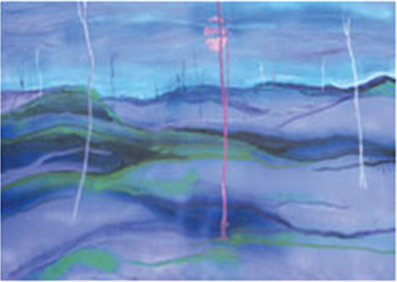Colin David
This is a collection of articles archived for the excellence of their content. Readers will be able to edit existing articles and post new articles directly |
Colin David
Recollections of Colin David
Like any other artist, David’s work evolved in many phases, but a constant motif of his work was his focus on the female figure. In a hostile environment and unpleasant circumstances, he kept painting nudes, even though he could not always exhibit, writes Quddus Mirza
The moment I mentioned Colin David while making a presentation on Pakistani art in India, the audience was astonished. They couldn’t believe Colin David was a Pakistani painter. For them, Pakistan is a strict, monolithic nation — populated with pious Muslims. Hence, it was unimaginable for them to hear about a leading Pakistani artist to be a Christian, and that too, a painter of the female nude.
Their surprise came as a shock to me, since we never thought of him an outsider in any way; either because of his faith, or because of his art practice. David was so much part of the art scene in Pakistan that one can’t think of it without him. He studied at the Department of Fine Arts in Punjab University and later at the Slade School of Art in London and taught for many years at the National College of Arts, where he was head of the Fine Arts Department, before retiring and devoting himself completely to his painting.
Even though he remained an active part of Pakistani art, in reality David was an outsider; in his choice of imagery, way of living and interaction with the art world, he was a different, often distinct person. But however distant he remained, he was a man greatly admired by the art community (one witnessed that love in the large gathering at his funeral). He was respected for his straightforwardness in life, dedication to teaching and mastery over his work. His canvases not only reflected a skilful hand, but also suggested the presence of an intelligent mind that was able of transcribe reality with minimal means.
In an interview, David defined drawing, not as a method of copying nature, but a practice to develop mind and eye coordination. For him art making was a cognitive act, rather than a craft — making surface after surface and turning these into hard currency.
Due to this temperament, he survived as an alien — particularly towards the end of his life —in an art world overflowing with commercial trend and monetary interests. Somehow David represented the old school and preferred the practice of painting for self expression rather than making it into a lucrative business. I remember once a gallery owner from Karachi came to NCA, visited Colin’s office, and asked for an exhibition. David politely declined saying he was not interested. A number of other artists also ignored the young gallery owner till they heard that he bought the entire show of a painter (planned for a prestigious gallery in the same city) and paid her in cash a sum of almost 2 lakhs (quite a hefty price tag a decade ago!). After knowing of this, several artists realised the worldly need to earn that kind of easy money and decided to exhibit with that rising businessman of art, but David refused repeated requests from him, in order to keep his integrity intact.
Integrity and commitment to his art were the qualities that he tried to infuse in his students. I recall a brief encounter with him when I was a second year student at NCA. I was desperate to have a one person exhibition and when I spoke to David about it, he clearly refused me the permission as well as discouraged the idea. Like any other student, I did not have pleasant feelings or polite words for him after this, but it took me another two or three years to recognise his wisdom and to acknowledge his role in guiding an ordinary student to the essence of art making, which lies beyond commercialism or quick success.
In the role of a teacher David was always present, available and accessible, yet he also spent his time painting or drawing in his office at NCA. Often I saw him, early in the morning before the college hours or in between classes, immersed in reading a novel. Perhaps the titles of those novels were important to shape his aesthetics — particularly his figurative composition; but his natural flair to denote the contours of the body and the impact of space in small delicate variations of colours and tones was unmatchable. At one stage of his life David used the elements of Op Art, but those were appropriated, assimilated and transformed in his later years’ works.
Like any other artist, David’s work also evolved in many phases, but a constant motif of his work was his focus on the female figure. In a hostile environment and unpleasant circumstances, he kept on painting nudes, even though he could not exhibit. When he finally did in 1990, his house was ransacked by a bunch of vandals, but even that did not discourage him from continuing to paint his favourite subject. His canvases signify an artist’s uncompromising attitude and an urge to swim against the tide. (This is probably what distinguished him from other artists in Pakistan).
Although in many respects he was different from a number of his contemporaries, but he had a great sense of camaraderie with them. His friends fondly remember him — especially the time when he was constructing his house in Defence, Lahore, and used to invite them to join him in laying bricks.
Today, not all of his friends are around (as a few are with David now), but may be those who are (including PNCA in Islamabad, the logical companion of all artists!) can revive the ritual and start laying bricks again — this time for a space for his art.


